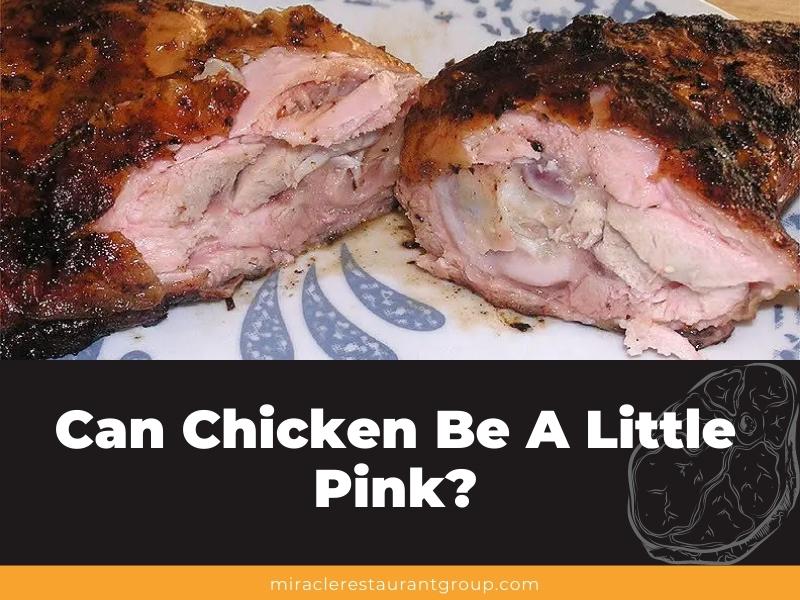Is It Safe for Chicken to Be A Little Pink? The Unraveling
Have you ever sliced into a grilled chicken breast, expecting to see a white, fully-cooked center, only to be met with a pinkish hue? If so, you’re not alone. The question – “can chicken be a little pink?” – often strikes uncertainty in the hearts of many home cooks and professionals alike. Is it a mere aesthetic oddity, or a sign of undercooked chicken that could lead to food poisoning?
In this in-depth article, we’ll explore the circumstances under which pink chicken is safe to eat, and when it could pose a potential risk. We’ll also delve into various aspects of the cooking process, including how to correctly measure a chicken’s internal temperature, the importance of resting the chicken before serving, and the intriguing role of myoglobin in creating pink hues in fully cooked chicken.
Decoding the Pink: Chicken’s Color and the Cooking Process
Chicken’s color can tell you a lot about its cooking status. However, it’s not always as straightforward as it may seem. Factors like the chicken’s age, whether it’s been marinated, and the type of cooking method used can all influence the final color of the meat.
Younger Chickens and the Pink Color Conundrum
Younger chickens often exhibit a pink color near the bone, even after being fully cooked. This can be attributed to their higher levels of hemoglobin and, more importantly, myoglobin in their muscle tissue. Myoglobin is a protein that carries oxygen to muscle cells, and it can create a pink or even red color when it reacts with heat during cooking.
The Role of Cooking Method and Temperature
The cooking method you choose can also contribute to the pink color in cooked chicken. For instance, grilling or frying can often result in a pinkish hue near the surface of the meat due to the Maillard reaction, a chemical reaction that occurs between amino acids and reducing sugars in the presence of heat.
Moreover, the USDA recommends cooking chicken to an internal temperature of 165 degrees Fahrenheit to ensure it’s safe to eat. However, even at this temperature, certain parts of the chicken, especially dark meat like chicken thighs, may remain pink. This is completely normal and safe, provided the chicken has reached the correct internal temperature.
Ensuring Safety: Chicken’s Internal Temperature and Proper Cooking
While color can give some indication of doneness, it’s not always a reliable gauge. The best and most accurate way to ensure your chicken is fully cooked is by measuring its internal temperature with an accurate cooking thermometer.
Using a Cooking Thermometer Correctly
When measuring a chicken’s internal temperature, you should insert the thermometer into the thickest part of the thigh, avoiding the bone. For whole chicken, you can also check the internal temperature in the breast and wing. The chicken is safely cooked when it reaches an internal temperature of 165 degrees Fahrenheit in all these places.
Slow Cookers and Lower Temperatures
If you’re using a slow cooker or cooking at lower temperatures for a prolonged period (for instance, cooking a rotisserie chicken for two hours), the chicken pieces may also turn pink. This doesn’t necessarily mean that the chicken is undercooked. As long as it’s reached the internal temperature of 165 degrees Fahrenheit, it’s safe to eat.
Resting the Chicken Before Serving
After you’ve cooked your chicken and verified its internal temperature, it’s crucial to let it rest before cutting into it. This resting period allows the juices to redistribute throughout the meat, contributing to a more moist and flavorful meal. After resting, if the juices are running clear, this is usually a good sign that the chicken is fully cooked.
The Risk of Undercooked Chicken: Food Poisoning and Bacterial Infections
The fear of serving pink chicken often stems from the fear of food poisoning and bacterial infections. Undercooked chicken can host harmful bacteria such as Salmonella and Campylobacter, which can lead to symptoms like vomiting and diarrhea.
In rare cases, undercooked chicken may also be a source of Avian Influenza, though this is typically more of a concern for those handling live poultry than it is for consumers of cooked chicken.
Other Factors Influencing the Pink Color in Chicken
Defrosting and Marinating
If you’re defrosting chicken in a microwave or marinating it in the fridge, especially in acidic marinades like those containing vinegar or citrus juice, you may notice a pink tinge. This is the result of a chemical reaction occurring within the muscle tissue and doesn’t mean the chicken is unsafe to eat.
Vacuum-Sealed Chicken
Similarly, vacuum-sealed chicken can sometimes have a pinkish hue due to the lack of oxygen. This color should disappear after the packaging has been opened and the chicken has been exposed to air for a few minutes.
The Aesthetics of Pink Chicken
While safe to eat, some diners might find pink chicken less than aesthetically pleasing. To avoid this, you might opt for cooking methods that generally don’t leave a pink color, such as baking, roasting, or cooking in a lidded cookware. Additionally, shredding the chicken can also help distribute any remaining pink hues more evenly, making them less noticeable.
Final Thoughts: Pink Chicken – To Eat or Not To Eat?
The key takeaway is that a pink color alone does not necessarily mean chicken is undercooked. As long as your chicken has reached an internal temperature of 165 degrees Fahrenheit, it should be safe to eat, even if parts of it are still pink.
However, if you’re unsure or uncomfortable with pink chicken, there’s no harm in cooking it a bit longer. Overcooked chicken may be a little drier, but it can still be tasty and satisfying, especially when properly seasoned and served with a juicy sauce or gravy.
FAQs
Can Chicken Be A Little Pink After Being Cooked For 2 Hours?
No, chicken should not have any pink color after being cooked for 2 hours. Properly cooked chicken should be fully white, indicating it’s cooked through and safe to eat.
Why is My Chicken Pink At 165 Degrees?
Chicken at 165 degrees Fahrenheit is considered safe to eat, but pinkness might be due to the presence of hemoglobin. If all parts reach the required temperature, it’s safe even if slightly pink.
What Should Slightly Undercooked Chicken Look Like?
Slightly undercooked chicken might appear pinkish at the bone and have translucent juices. Ensure juices run clear and all parts are white before consumption to avoid risks.
Is Chicken Ok If Slightly Pink?
Chicken can be safe if slightly pink, especially near bones, as long as it reaches the recommended internal temperature of 165 degrees Fahrenheit and the juices run clear.
Why is Chicken Slightly Pink?
The presence of myoglobin, a protein in muscles, can cause a slight pink hue. This doesn’t necessarily mean it’s undercooked, but it’s crucial to check temperature and juices for safety.
How Can You Tell If Chicken is Undercooked?
To check for undercooked chicken, use a food thermometer to ensure it reaches 165 degrees Fahrenheit. Additionally, pierce the thickest part; if juices are clear, it’s properly cooked.
Related Articles:

The Best Grilled Chicken: How Long to Grill Thin Chicken Breast for Juicy Results
I’m Calvin Lamb, an LA-based culinary enthusiast with a decade’s experience in five-star kitchens. My innovative dishes, inspired by seasonal flavors and sustainable practices, blend classic and modern cuisine. Besides crafting unique culinary experiences, I relish exploring new eateries and devising fresh recipes.


Good day I am so thrilled I found your site, I really found you by error, while I was looking on Aol for something else, Anyhow I am here now and would just like to say thank you for a fantastic post and a all round interesting blog (I also love the theme/design), I don’t have time to browse it all at the minute but I have saved it and also added in your RSS feeds, so when I have time I will be back to read a lot more, Please do keep up the fantastic work.